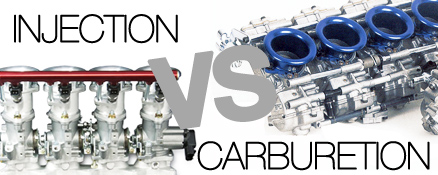
Old school nuance against new-school high-tech wizardry. Complex head butting against simplicity. That is the battle that is EFI vs CARBS. 4A-GE engines have had both strapped to them in almost equal measure for as long as 4A-GE engines have been in existence.
Whether its multiple throttles or multiple carbs, Toyota’s venerable 4A engines have benefitted in hugely with either set up. A carb-equipped 4A-GE is as simple as bolting on a weber or mikuni manifold and getting the mixtures right, in comparison a running multi throttles correctly requires the softly softly approach and plenty of tweaking. Which is better?
SUCK AND BLOW
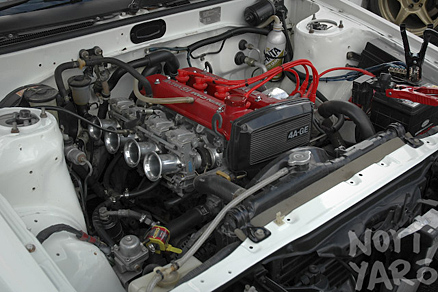
First up I have to declare, I really dislike carbs. I dont know exactly why. Maybe it was dealing with my sometimes disgruntled 4A-C, or trying to find someone who knew about carbs. Anyway I don’t like them at all… Now having said that, there is nothing better than hearing a 4A-GE on full song screaming through a set of wide open carbs!!
Obviously the carbies trend has been around for long time, as carbies have been around since the dawn of the motor car. Fitting multiple carbs to engine to enhance it performance is nothing new either.
Almost all cars pre 1980 used carburation as means of mixing fuel and air, all but the most expensive or exotic cars that is. Most of the “performance” cars of the day usually ran a single carb with a larger jet than the poverty pack or mum & dad special.
But of course some people always want more power just so they could beat Johnny Lunch-pale at the traffic light Grand Prix. They played around with bigger jets or bigger carburettors just to make power and of course some times it worked and some times it didnt.
Once you fitted multiple carbs things started to get serious…
…And the 4A-GE was no different. Coming injected and dual over head cam (or twin cam) from the factory, many of the Japanese tuners at the time didn’t really know how to get much more power out of this mysterious box of resistors and wires.
So what did they do? They turned to what they new best by taking off the injection manifold and strapping on a set of carbs!!
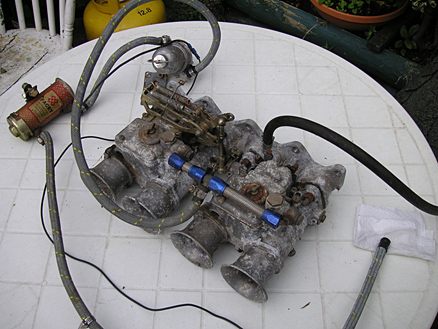
Even today in japan its a almost a 50-50 split between carbs and injection for a 4A-GE engine. Mostly due to workshops having limited access to a dyno’s to correctly tune an injection engine, so using a set of bike carbs and tuning on the road is the best thing they’ve got.
Even in the top level N2 races almost half the field use multiple carb setups and tune the cars by ear. Most of these are privateers but there is still a number of large well known work shops using multiple carbs.
So why would they use carbs? Well one of the main reasons is for the simple fact is that they are cheap. A set of carbs off a rusting or smashed honda, suzuki, or yamaha bike is a damn sight cheaper than finding a set of individual throttle bodies and finding a suitable ECU to run it on.
There are many different types of carbs available too. The well known European ones such as Weber and Dell’Ortos, through to ones used on the Pommie sports cars like Strombergs and SU Carbs.
Each has their individual traits with the Dell’Ortos and Webers being quite similar to each other and much easier to tune. The japanese in there infinite forward thinking did probably the best thing they could ever do and that is the Mikuni carb.
Almost all Harley owners who have a carburetted bike use Mikuni carbs (although they call it “American Mikuni” to dissociate themselves from the Japanese).
What the Japanese engineers did back in the 60’s was take a a Weber carb, strip it down, refine it and make it much simpler while being less cantankerous than any of the European carbs.
The other popular Japanese carburettor is the Keihin FCR carburettor which is a flat slide, side and down draught carb. What a flat slide carb has is instead of a rotating butterfly it has a flat sliding plate covering the fuel jets and when slid open forces air into the carb itself. A harsher but more effective power delivery is the result.
INJECTION PERFECTION
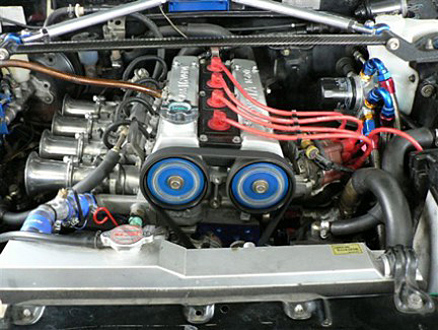
With the advent of the 80’s digital era everything was injected and “Turbo”. The 80’s is really the decade where fuel injection took off, and where the Japanese manufacturers really came into their own. All the big manufacturers and even the small ones were turning to fuel injection and turbo charging for their performance vehicles.
Toyota was no exception in that regard. All their top luxury or performance vehicles were injected or turbocharged. The motoring world had changed forever.
In the mid 90’s the 4A-GE seriously changed and went from 4 valves per cylinder to 5 valves per cylinder, they also added individual throttle bodies as well for good measure. The 20 Valve 4A-GE engine was born!
And of course it used injection. An electronic ECU controlled the injectors squirting (or pulsing) and mixing it with air and then being burned in the combustion chamber. And that is injections biggest advantage, its set and forget nature. Nothing changes settings or wears out, nothing will clog and sputter and electronics makes it possible!
EFI v CARBS

Using injectors it provides a precise metered amount of fuel to the incoming air. Unlike carbs with the more air being sucked in tends to increase fuel at a high RPM rate to mix with the air. So the higher you are in the RPMs the more likely you are to run much richer using carbs, leading to the common belief that carbs use much more fuel that injection.
In some ways this is true, as carbs do tend to use more fuel than an injection set up due to jets and bowls as it is not as accurate as a electronically controlled injectors. But using a properly set up multi carb intake and manifold, the carbs will not use much more fuel that a similar set up injection system.
Most people are of the belief that injectors use far less fuel than a carburettor, but again its not entirely correct. If you use a factory ECU and upgrade things like an exhaust manifold, exhaust system and cold air intake the factory ecu may not be able to adjust to this new found effiency. So when you mash the loud pedal it may just dump fuel in making a poofteenth more power but you will be using more fuel.
The factory ECU on all injected cars come with have hard wired protection systems so when your driving your car hard it squirts more fuel in to keep up with the air flow demand and to try to cool the engine as well (more fuel + less air = smaller bang and less heat) so it does not do any damage to the motor.
Now which do you choose?
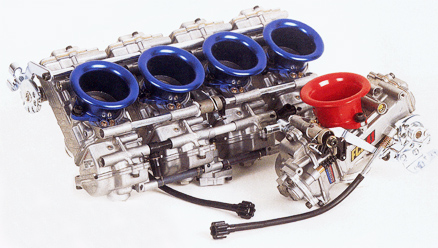
Well carbs can be quite cheap to set up as a side draught carb manifold are a snap to make or adapt to almost any engine. Carbs themselves can be quite cheap as there are lots of damaged bikes and rusting Alfas and Fiats about. Rebuilding a carburettor is quite simple as well, there are off the shelf kits available for almost all carburettor systems.
If you need increased fuel flow its very cheap to increase the jetting of the carbs or replace the jets for larger ones. Doing so is a bit like increasing the injector size, but too big and you will constantly run rich and flood the carbs, and sometimes the engine, with fuel. too small and you will strangle the mid to top end of your engines power band.
Getting the mixtures right on carbs, especially multiple carbs, can be quite difficult. Its a matter of fine tuning and tweaking each one to get it right until you have the best balance. As of late it is becoming increasingly difficult to find old school carbie tuners who know what they are doing or have experiance with your particular set up.
You also have to check the carbs on a regualr basis to make sure they haven’t gone “out of tune”, meaning through regular driving and vibrations they may come out of tune requiring adjusting again to get back to the correct mixtures.
With carbs usually you lose a fair bit of low down torque until about the middle of the rev range when the carbs really can open up and let rip. So driving around town may not be the best thing with a multi carb’d engine. On a winding road or at the track the carbs would really excel. Also as you have very minimal electronic trickery to restrict anything you dont have a rev limiter so there is no fun police if you spin it too hard. Be aware though that the car may lean right out causing major damage if you over rev the engine…
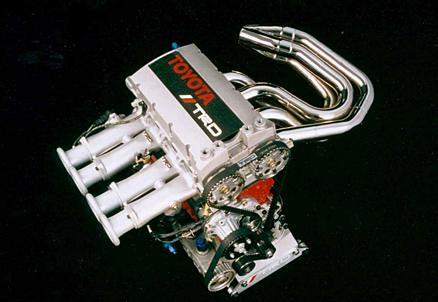
On the other hard setting up individual throttle bodies (ITBs) and injection is quite expensive. First up you really should a have a programmable ECU, which can take a sizable chunk of cash depending on which brand you buy. Then the ECU has to be set up, which requires wiring and tuning.
If you have a programmable ECU that can plug into a lap top computer you could have a go at tuning the ECU yourself. But this is fraught with problems as pushing it too much one way or the other you may end up with a very expensive paperweight on your hands.
But using a programmable ECU you have infinite control over the engine than you would if using a carburettor-based system. You can control how much fuel goes in at specific RPM, specifically when the fuel goes in so if you have large duration cams you can time it so its in between the rotations, you can also control the spark. In fact, with most modern ECU’s there really isnt anything you can’t control.
Again with ITBs and injection you can also get a precise amount of air and also have the correct amount of fuel to air mix in the combustion chamber.
Once the programmable ECU is tuned correctly it is saved as a tuning map and is a set and forget system. Meaning that once the tuning is done you do not have to adjust it again unless you change something on the engine.
Unlike carbs or multiple carbs, using injection and ITBs you have a good even spread of power and torque all the way through the RPM range instead of having nothing down low and all the power up high in the RPM range. So that means that you have adequate low end torque to pootle about town in and taking off from lights without out revving the crap out of it.
FORCED INDUCTION
Having not seen a decent suck through or blow through turbo set up in a long time, the black art of turbo charging a carbie engine is almost gone.
With a carbied turbo engine you have 2 options, suck through or blow through set up. A suck through system is just that it sucks air and fuel through a carburettor first then through the turbo to be pressurized and fed into the engine. This is a cheap and simple way to set it up, but is quite in-efficient.
A blow through set up has the carburettor after the turbo (much like a conventional injected set up) and air is forced into the carburettor. This way is a much better set up and much more efficient than a suck through system, but is more difficult to set up as the carburettor must be able to take boost and work under pressurized conditions.
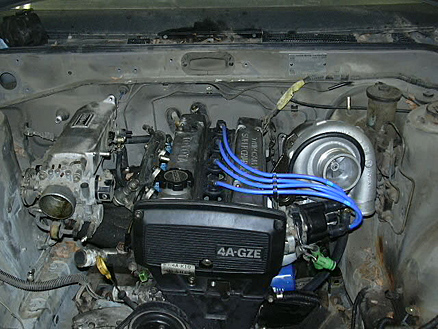
A turbocharged injection engine as you already know is much easier and much, much more efficient than any turbocharged carbie set up. The injection system already has an intake chamber or plenum already able to take boost, and you can control the fuel and boosted air intake at a much more managable rate.
With injected engine you can run a supercharger, compared with a carbie system its almost impossible on a small capacity engine to run a supercharger efficiently.
I HAVE THE POWER!
A multi carbed or ITB’d N/A engine in terms of power output, there really isnt much in it at all. Both will make similar levels of power at almost similar RPM limits.
A turbo carbie engine is really only going to make a few HP more than a similar sized multi-carb’d or ITB’d N/A engine. Looking at some old fast fours from the early 90’s the average power output of a 2ltr carbie turbo engine was around 200-250hp. Nowadays the skies the limit for a injected turbo engine and you can buy a car off the showroom floor with more power from similar or less capacity and NON-TURBO!
So a injection setup may be more expensive to set up initially, but once its all in place you dont have to do anything after that except enjoy the sweet trumpet music.
Carbs are cheap to set up, can be a barstard to tune and get right. But when done correctly run they will sweetly and have the most insane raucous bark to them everyone will know you mean business.
What’s the better option? Well, thats for you to decide!




12 Responses to The Endless Argument: EFI or CARBURETION